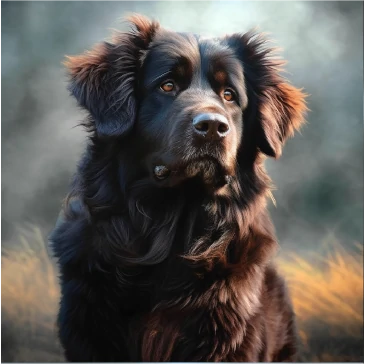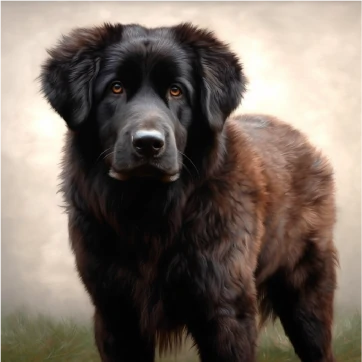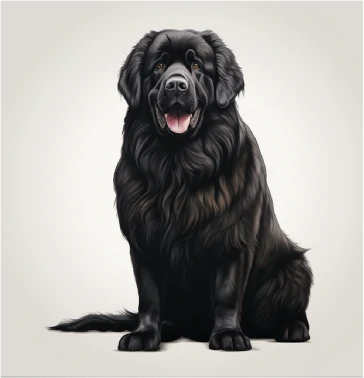Charming Newfoundlands Breeder Despite their imposing size, Newfoundlands are intelligent and affectionate companions that seamlessly integrate into family life.
With a strength akin to a bear and aquatic prowess reminiscent of a fish, Newfoundlands can't escape their legacy as invaluable helpers to fishermen, rescuing nets and boats. This strength, endurance, and love for water persist today, making them beloved family dogs worldwide.
Varieties of Newfoundlands Breeder In the realm of Newfoundlands, two variants are distinguished based on their size:
Origin:
Newfoundlands have their roots in Newfoundland, Canada.
Lifespan:
On average, Newfoundlands live between 8-10 years.
Head:
Exceptionally long and narrow, well-proportioned.
Coat:
Long and somewhat silky, commonly with white patches, in various colours.
Weight:
Males: Average weight is between 75 and 105 pounds (34-47 kilograms).
Females: Average weight is between 60 and 85 pounds (27-38 kilograms).
Weight Range:
Males: 59 - 68 kg
Females: 45 - 54 kg
Height:
Males: Typically between 32-34 inches at the shoulder, excluding the head.
Females: Slightly smaller, generally between 28-30 inches at the shoulder.
Height at Withers:
Males: 71 cm
Females: 65 cm
Temperament:
Despite misconceptions, the Newfoundland's temperament is genuinely calm and composed.
Characteristics:
Dropped ears (naturally)
Energy Level: Relaxed
Lifespan: 8 - 10 years
Drooling Tendency: High
Snoring Tendency: Low
Barking Tendency: Low
Digging Tendency: Low
Need for Attention/Socialization: Moderate
Bred for:
Multi-purpose water dog, fishing aid
Coat:
Length: Medium
Features: Double layer, smooth
Colors: Black, Brown, Gray

Newfound Glory Breeds
Origin:
Hailing from the picturesque island of Newfound, these doggos boast unparalleled swimming prowess, shrouded in the mystery of their lineage. Rumor has it, they might share kinship with the loyal Mountain Dogs of the Pyrenees, companions to local fisherfolk. In the 18th century, Newfound set sail for the UK and France, winning the hearts of English sailors as adept shipmates.
Maritime Heroes:
The Newfoundland legend unfolds in their aquatic rescue finesse; two of these canines emerge as indispensable heroes in English coastal search and rescue teams.
Shipboard Maestros:
As onboard dogs, Newfounders surf the waves with ropes clenched, establishing vital links between ships and solid ground. Beyond being swimmers, they are aquatic heroes, capable of towing small boats to the safety of the coast.
Nocturnal Valor:
A tale of nighttime bravery credits a Newfoundland for plunging from the deck to rescue Napoleon Bonaparte from icy waters.
Island Heritage:
Originating from Canada's Atlantic island of Newfoundland, these weather-resistant canines defy harsh conditions with towering stature and an innate love for water. Their tireless duties range from hauling heavy loads to retrieving nets and boats from the ocean. Their legacy extends beyond the island, solidifying them as unparalleled working dogs.
Mystical Origins:
Though the exact roots of this breed are veiled in mystery, suspicions arise of crossings between early European fishermen's dogs and indigenous Canadian cultures, the Micmac and Beothuk. The original island type fused with diverse European influences and the possible influence of Arctic sled dogs, such as the polar dogs of the Innu and Inuit. Dismissed is the theory of the large black bear-dog introduced by the Vikings in 1100, enriching the Newfoundland myth with a unique and captivating origin.

Newfound Companionship
Overview:
Newfoundlands, affectionately known as "Newfies," have been selectively bred to be versatile workers, excelling in tasks like fishing and cart-pulling. However, their true joy lies in sharing long walks and quality time with their families. They crave constant companionship and prefer to be wherever you are.
Living Dynamics:
Newfies thrive when living indoors, happily accompanying you on your ventures outside. While they may tolerate being left alone at home, it's crucial to provide them with a secure environment, preferably with access to a garden. Avoid confining them to a small backyard or kennel, as this could lead to antisocial behavior and sadness.
Behavioral Consequences:
Puppies raised in isolation may become antisocial, disobedient, and unhappy. Undesirable habits, such as destructive behavior and excessive barking, may develop. Similarly, adult Newfoundlands subjected to extended periods of solitude may experience profound sadness. If you're unable to spend ample time with your dog due to work or other commitments, it's advisable to consider a breed less dependent on constant human company.
Choosing the Right Breed:
It's essential to recognize that no dog can truly thrive without human companionship. Breeds such as hunting dogs or Newfoundlands, which flourish in groups or pairs, tend to handle long hours alone in a yard more gracefully.

Nurturing Nature
The Newfoundland dog possesses a sweet temperament and feels equally at home on land or in the water. Ideal as a companion for individuals or families, it's important to consider their size. While adult Newfoundlands don't require excessive exercise, they do benefit from daily walks, a run in the yard, or, particularly, a swim to stay in good shape. Maintaining a healthy weight is crucial, as excess weight can impact their already short lifespan, typically between eight and ten years.
The Newfoundland is a true blessing—always calm, peaceful, and gentle. Its benevolent and tranquil character is evident in the kind gaze of its loyal, dark eyes. These qualities make this gentle giant an ideal family dog. Children, in particular, form a close bond with the Newfoundland. Beyond its playful nature, the dog impresses with its respect and patience when interacting with kids. It also demonstrates deep attachment and loyalty to other family members, craving intimate contact and enjoying being a part of every moment. Affection and caresses from loved ones bring immense joy to this breed.
The Newfoundland dog is known for its attentive and amiable nature, making it highly tolerant of childish behavior. This breed excels in adapting to family life and thrives on the love and attention showered upon it by its human companions.

Nutritional Requirements of the Newfoundland
Rapid Growth:
Like other large breeds, the Newfoundland requires a substantial diet during its first year, gaining up to 45 kg during this period. However, as they mature, their metabolism slows down, and the daily caloric intake decreases. It's essential to maintain a balance, prioritizing the dog's health over weight. A lean Newfoundland is often healthier than an overweight one.
Main Source of Proteins:
In general, dogs' diet should be protein-rich, with meat being the most crucial source, constituting about 70% of their diet. It can be provided in the form of high-quality kibble or wet food. Another approach is to follow the BARF/ACBA (Biologically Appropriate Raw Food/Autoimmune Protocol) method. This method mimics the original dog diet, including raw meat, organs, vegetables, and vitamin and mineral supplements. It's crucial to thoroughly research this feeding method and understand the specific nutritional needs of the dog to avoid harmful deficiencies. If in doubt, consulting a trusted veterinarian is recommended.
Fruits, Vegetables, and Grains:
In addition to meat, the Newfoundland should consume fruits and vegetables in a proportion of 20-30% to ensure adequate intake of vitamins and trace elements. Grains should be minimal in the diet. Also, it's crucial to ensure that the dog always has access to fresh water.

Newfoundland Breed Overview
Resilient Nature:
The Newfoundland breed is known for its robustness. Regardless of the weather conditions, these dogs are eager to venture outdoors. Rain, cold, and wind don't dampen their spirits. However, Newfoundlands are not fond of excessive sunlight, as they historically hail from the rigorous climate of Canada.
Fur Care:
Their thick coat, providing excellent protection against water and wind, demands extensive care. Special brushes are a must for daily grooming. Avoid using combs, as they can pull hair even when healthy, causing harm. Regular care is also needed for the eyes and ears. Dental cleaning is usually sufficient with chew bones.
Considerations for Prospective Owners:
Prospective Newfoundland owners should be aware of the laborious care required for such a large and furry dog. Those who highly value cleanliness might want to reconsider getting this furball. Meeting their need for outdoor exercise and passion for swimming is essential. A spacious natural area with its garden near a lake for swimming is a Newfoundland's paradise. City living is not suitable for them. Long walks are not as crucial as the opportunity to swim. Excursions to a lake or coastal vacations (near a dog-friendly beach) should be part of your plans.
Perfect for Active Families:
Newfoundlands are ideal for active and dynamic families looking to include their furry friend in adventures. Their love for water closely follows their affection for people.
Exercise and Special Care
Exercise Needs:
Despite their large size, adult Newfoundlands don't require excessive exercise. However, ample space for movement is essential. Swimming is their favorite activity to stay happy and fit, so providing access to water or occasional seaside walks is recommended.
Special Care Requirements:
Newfoundland care involves regular grooming, with a minimum of two weekly brushing sessions for their coat. To prevent skin irritation, use a pH-friendly shampoo. If swimming frequently, consider using anti-parasitic treatments to maintain skin health.

Common Health Challenges in this Breed
Although this breed generally enjoys good health, it is not immune to the typical issues faced by large dogs.
Common Health Conditions:
Some of the typical health conditions found in dogs of this breed include:
Preventing the Aforementioned Conditions:
Hip dysplasia can be prevented by avoiding excessive exercise during the puppy stage. Cystinuria, on the other hand, can be mitigated through a DNA test.
Coping with Breed-Specific Ailments:
Despite the best efforts of breeders and veterinarians, certain diseases common to the breed are inevitable. Like many large dogs that grow rapidly, some Newfoundlands may experience joint problems, particularly in the hips and elbows. Other orthopedic issues, such as cruciate ligament rupture, dilated cardiomyopathy, and bone cancer, are also prevalent.
Minimizing Risks:
While it's impossible to completely eliminate these diseases, choosing a reputable breeder and providing proper care, along with nutrition aligned with the breed's needs, can significantly reduce the risks. A responsible breeder will offer guidance on ownership, care, and training, providing a tailored nutritional plan for your puppy. Gradual dietary changes are important to prevent digestive problems. Regular veterinary check-ups and diligent attention to basic immunization are essential for their well-being.